Nature’s Best Photography (NBP) has revealed the 2025 Winning Images, celebrating the creativity, patience, and passion of photographers from around the world. This year, more than 20,000 breathtaking submissions poured in from dedicated nature and wildlife photographers across 62 countries.
After months of careful review by an esteemed panel of judges, editors, and advisors, nearly 500 images advanced to the semi-final round. From there, a detailed evaluation of high-resolution files and the inspiring stories behind each photo led to the selection of the Top 100 finalists.
Scroll down to explore some of the most powerful and captivating photographs that made it to this year’s finals.
More info: new.express.adobe.com | Instagram | Facebook
#1 Highly Honored, Wildlife: Bighorn Sheep By David Swindler Of Kanab, Utah, USA

Image source: naturesbestphotomagazine
#2 Highly Honored, Art In Nature: Shining Antlers By Kohei Nagira Of Izumo, Shimane, Japan
“In early spring, male Ezo sika deer begin to grow new antlers. Covered in velvet — skin rich with blood vessels and nerves — these antlers develop rapidly and can reach full length by summer. When struck by sunlight, they glow with a delicate, golden light.
This photo was taken in Kushiro, Hokkaido, where deer are commonly seen and often considered pests. It is not a remote wilderness, but an ordinary place where nature and people coexist. Still, even in such settings, beauty can emerge through vision and timing.
I had a clear image in mind before shooting. To create a glowing silhouette, I deliberately underexposed the scene and waited for the deer to be perfectly backlit. The soft hairs on the velvet antlers caught the setting sun, forming a radiant crown of light. I used no flash, maintaining a respectful distance to avoid causing stress. With patience and intention, a familiar subject became something quietly powerful.
This image reminds us that even in ordinary surroundings, nature’s quiet transformations deserve our attention — and our care.”

Image source: naturesbestphotomagazine
#3 Highly Honored, Outdoor Adventure: Night With The Ancients By Paul Zizka Of Banff, Alberta, Canada
“Nighttime with the Ancients: I only spent one night with these giants, but I would have gladly stayed much, much longer. The baobabs of Baobab Alley in Madagascar are a breathtaking natural wonder. Towering up to 30 meters high, these ancient trees—some over 800 years old—stand like silent giants along a dusty road, their massive, bottle-shaped trunks and sparse canopies casting surreal silhouettes against the night sky. I added myself to the frame to emphasize the sense of scale. Revered by locals and admired by travelers, the baobabs are not just trees—they’re sacred monuments to time, resilience, and nature’s grandeur. Baobab Alley is a place where the majesty of the natural world is laid bare in stunning simplicity.”

Image source: naturesbestphotomagazine
#4 Highly Honored, Landscapes: Campton Pond Sunrise By Harry Lichtman Of Newmarket, New Hampshire, USA
“I had passed this pond hundreds of times over the years on my way to nearby mountain hikes or cross-country skiing, but I was never drawn to photograph it—until now. On this autumn morning, my original plan was to hike a nearby mountain for sunrise. The foliage color and patchy fog looked so idyllic that I quickly changed my plans to see what light might develop over the pond at sunrise.
After choosing a composition along the shoreline, I heard geese honking in the distance. They eventually flew by me, but it was still too dark to photograph. As the sky began to color, I started taking exposures at low ISO and slightly longer shutter speeds, as I typically would in still conditions. When I heard Canadian geese again in the distance, I quickly adjusted my settings to faster shutter speeds to capture them sharply if they flew by.
I could see the flock approaching the pond and took several exposures as they passed. Their presence added a dynamic element, making the image far more compelling than the pond alone.”

Image source: naturesbestphotomagazine
#5 Winner, Conservation Single Image: Sri Lankan Asian Elephant In Waste Pile By Lakshitha Karunarathna Of Colombo, Sri Lanka
“A lone Sri Lankan elephant stands atop an endless sprawl of discarded waste—its massive form surrounded not by forest, but by a kaleidoscope of plastic, polythene, and household debris. This image is part of a long-term photographic project documenting the devastating realities of the human-elephant conflict in my country.
Sri Lanka is home to more than 10% of the global Asian elephant population, yet their survival is increasingly jeopardized. Encroaching waste sites near vital dry-zone forests are frequently visited by elephant herds, and many individuals ingest microplastics and other non-biodegradable materials, often leading to fatal internal injuries.
Only a drone can reveal the true scale of this crisis. To achieve this visual ‘shock,’ I needed perfect alignment: a break in the rain and the position of a lone elephant on a vivid patch of waste—while operating the drone safely in monsoonal winds.”

Image source: naturesbestphotomagazine
#6 Highly Honored, Art In Nature: Path Of The Brittle Star By Alan Smith Of Reading, Berkshire, UK
“The stunning seascapes around Luskentyre Beach draw photographers from all over the world. I found myself there one dank, granite-grey November morning. With limited photo options, I challenged myself to create an image that told the story of the day. Searching for a subject, I noticed a disturbance in the otherwise perfectly smooth sand—a starfish. As I studied its body, I observed the indentations in the sand becoming narrower and lighter as it had attempted to make its way to the ocean. The now-lifeless brittle star’s final journey would remain visible only until the briny blanket of water washed it back to the sea, but the artful design it created allowed me to capture this story in a single photograph.”
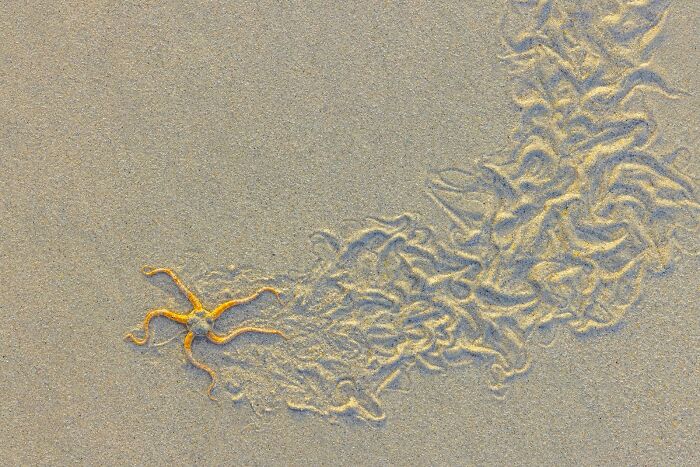
Image source: naturesbestphotomagazine
#7 Highly Honored, Landscapes: Cinque Torri By David Swindler Of Kanab, Utah, USA
“It was an atmospheric, foggy morning as the early light began to illuminate the surrounding towers and mountains. I loved how the fog framed Cinque Torri in the distance.”

Image source: naturesbestphotomagazine
#8 Youth Photographer Of The Year: Great Hornbill In Flight By Lisiqi Ye, At Age 17, Of Beijing, China
“During breeding season, Yingjiang’s Hornbill Valley runs on ritual. I spent days in a hide facing a fig-rich cavity claimed by a pair. Each time the male returned, I tallied his actions: mud at the rim, a test landing, a flicked fig into the dark—rehearsals to persuade her to enter and stay. On the day I captured this image, he came home heavy with fruit. He faced the wind, bled off speed; wingbeats drummed, and his casque caught the sun. He skimmed so close the camera I could feel his breath. I pressed the shutter as he hung, weightless, at the hollow’s mouth. By afternoon, the female had sealed herself in, and it was time for the male to begin his long shift of deliveries.”

Image source: naturesbestphotomagazine
#9 Highly Honored, Ocean Views: Leafy Sea Dragon By Nicolas Remy Of Sydney, Nsw, Australia
“Leafy sea dragons are a favorite subject for underwater photographers, yet they are fragile creatures—poor swimmers that cannot easily flee. To minimize disturbance, I dived solo (with appropriate certification) and used a rebreather, allowing me to move quietly and without bubbles.
Over four days, I spent more than 22 hours in the water, taking all the time needed to ensure relaxed encounters. In one patch of reef, I was lucky to find three adult sea dragons living close together. I moved slowly between them, simply observing, and swam away whenever other divers approached to give the animals space. I only approached when a dragon was both calm and in a position that matched the image I had envisioned.
My goal was to create a symmetrical portrait highlighting the shy creature’s delicate appendages against a black background. To achieve this, I used a snoot to narrow the beam of my strobe and adjusted my exposure settings to minimize ambient daylight. Before moving in, I pre-set and tested my lighting on a piece of algae. When one dragon finally held still in perfect alignment, I inched forward and captured just a couple of frames.”

Image source: naturesbestphotomagazine
#10 Highly Honored, Art In Nature: Mozambique Ghost Goby By Simon Biddie Of Edinburgh, Scotland, UK
“Small reef fish, unassuming and often unseen, are a critical part of reef food chains. They evade predators by being experts at hiding. These small fish are also known as ‘cryptobenthic’ fish — ‘crypto’ because they hide in crevices or use camouflage. This photograph of a Ghost goby demonstrates just how adept these tiny fish can be at concealment.
Growing to about 2 cm long, they are perfectly adapted to blend in among coral. Their transparent bodies, fins with suction for a firm grip, and low-set gills minimize movement, helping them avoid predators. Meanwhile, their large, angled eyes constantly scan for plankton.
This image was taken on a morning dive in Marsa Alam, southern Egypt, along a Red Sea reef wall. Using a macro underwater setup while scuba diving, I captured the Ghost goby against hard coral, with the coral polyps forming textured spots in the background. The scene was lit with strobes, and a small aperture ensured both the subject and background remained in focus. This sharp focus highlights how the Ghost goby blends seamlessly into its dichromatic coral environment.”

Image source: naturesbestphotomagazine
#11 Highly Honored, Art In Nature: Desert Layers By Matteo Strassera Of Rome, Italy
“The beauty of the desert is subtle and often difficult to capture. To the untrained eye, it may appear as an immense expanse of sand — flat, monotonous, and always the same. However, if you look more closely, you will notice that no two dunes are identical; each differs in shape, size, and texture. Spending a week in one of the largest Arab deserts, Rub’ al-Khali, taught me to pay attention to these small details, to recognize abstract figures and shapes in a landscape that seems sculpted by human hands rather than chaotically shaped by wind and nature.”

Image source: naturesbestphotomagazine
#12 Highly Honored, Landscapes: Mirror Image Of Baobab Avenue By Felipe Foncueva Of Madrid, Spain
“The baobab is not only a widespread tree in Madagascar but also holds magical and spiritual significance for the locals. Sunrises and sunsets in front of these giants are breathtaking. In this shot, I wanted to use the mirror effect with the backlit silhouettes, creating a sense of symmetry in the image.”

Image source: naturesbestphotomagazine
#13 Highly Honored, Birds: Bohemian Waxwings By Amy Gerber Of Cody, Wyoming, USA
“If Mother Nature had a Christmas tree, it would be this one — a tree past its prime, holding on for its last few breaths. Its little cones, filled with tiny seeds, will scatter across the landscape when the time comes. But for now, it serves as a resting post for weary birds that have flown hundreds, even thousands, of miles from the far north.
This species, the Bohemian Waxwing, migrates to Wyoming each winter from Canada. They spend the season gorging on juniper berries, which grow abundantly here, before heading back north in spring. These waxwings don’t seem to mind that the tree has lost its green, youthful glow. In fact, the rusty needles perfectly match the rusty crowns of each bird — a harmony I found breathtakingly beautiful.
So, if Mother Nature could design the perfect Christmas tree, I think it would look just like this. I love winter photography and often find myself out in the Shoshone National Forest almost every day during the season. There’s something clean, fresh, and profoundly beautiful about cold, snowy environments, and I take full advantage of every opportunity to capture them.”

Image source: naturesbestphotomagazine
#14 Highly Honored, Ocean Views: Sally Lightfoot Crab By Kevin Lohman Of Santa Cruz, California, USA
“A Sally Lightfoot Crab rests on the striking, iron-rich red sand of Rabida Island in the Galápagos. The sand’s vivid hue comes from volcanic material rich in iron oxide, a feature unique to the islands. The crab’s brilliant reds, oranges, yellows, blues, and purples stand out in bold contrast against the deep brick-red shore. Finding it higher on the beach, away from the surf, allowed me to lie flat on the sand and photograph it at eye level—capturing its vivid colors against this extraordinary shoreline.”

Image source: naturesbestphotomagazine
#15 Highly Honored, Outdoor Adventure: Cowboy Riding In The Snow By David Swindler Of Kanab, Utah, USA
“It was a cold winter day with fresh snow on the ground when we went out to photograph these talented horsemen and women. We found the perfect hill in front of the setting sun. As they galloped, snow, dust, and moisture from their breath created beautifully atmospheric backlit conditions.”

Image source: naturesbestphotomagazine
#16 Winner, Grand Prize: Emperor Penguins By Thomas Vijayan, Ontario, Canada
“Emperor penguins in Antarctica epitomize extraordinary familial bonds. Within the icy expanse, these majestic creatures orchestrate a delicate symphony of cooperation and nurturing to safeguard their chicks against the unforgiving polar conditions. Both parents actively participate in the intricate dance of parenthood, alternating between egg incubation and foraging expeditions in the icy depths.
Before capturing this moment, I spent hours lying flat on the sea ice, patiently allowing the penguins to acclimate to my presence. Gradually, I began photographing them from various angles, capturing their intimate interactions. This particular image holds a special place in my heart as it portrays the profound familial affection shared among these remarkable birds.
Within their synchronized embrace, the chicks find solace, nestled in the warmth of their devoted parents amid the icy wilderness. This tender display of familial unity speaks volumes about the resilience and fortitude of life in one of the harshest environments on Earth.”

Image source: naturesbestphotomagazine
#17 Highly Honored, Animal Antics: Mountain Hare, Monadhliath Mountains By Andy Parkinson, Crich, Derbyshire, England, UK
“Nature has an uncanny knack for delivering the unexpected. In this moment, the hare stretched out its hind leg directly toward me, as if to salute—or offer a high five (or four!). Either way, this completely natural and relaxed behavior was a clear sign that the hare felt completely comfortable in my presence.”

Image source: naturesbestphotomagazine
#18 Highly Honored, Polar Passion: Musk Oxen Confrontation By Daniel Valverde Fernández Of Madrid, Spain
“This shot shows a close-up of two musk oxen (Ovibos moschatus) as they test their strength in a light confrontation. Capturing this image was truly challenging, as these animals are found on the summits of Dovrefjell, and I had to walk around 15 km through fresh snow to reach them. They are also quite skittish, so you have to approach slowly to get a close-up like this. A bit of luck is also needed to capture such a magnificent moment. This ancient species was nearly driven to extinction due to mass hunting and can now only be seen in the most isolated regions of the Arctic Circle.”

Image source: naturesbestphotomagazine
#19 Highly Honored, Wildlife: Sumatran Orangutan On Strangler Fig By Marco Gaiotti Of Genova, Italy

Image source: naturesbestphotomagazine
#20 Highly Honored, Wildlife: Flying Foxes By Baiju Patil Of Maharashtra, India

Image source: naturesbestphotomagazine
#21 Highly Honored, Animal Antics: Leopard And Elephant Face-Off By Pierluigi Rizzato Of Borgoricco, Italy
“A leopard was resting on a fallen dead tree when an elephant roamed across the savannah and noticed it from afar. Curious, the elephant approached for a closer inspection. The leopard, much smaller than the pachyderm, did not flee; instead, it held its position, watching the elephant’s behavior. After examining the situation carefully with the tip of its trunk, the elephant calmly decided to move on and walk away.”

Image source: naturesbestphotomagazine
#22 Highly Honored, Animal Antics: Eurasian Goshawk Chicks And Butterfly By Ming Chen Of Beijing, China
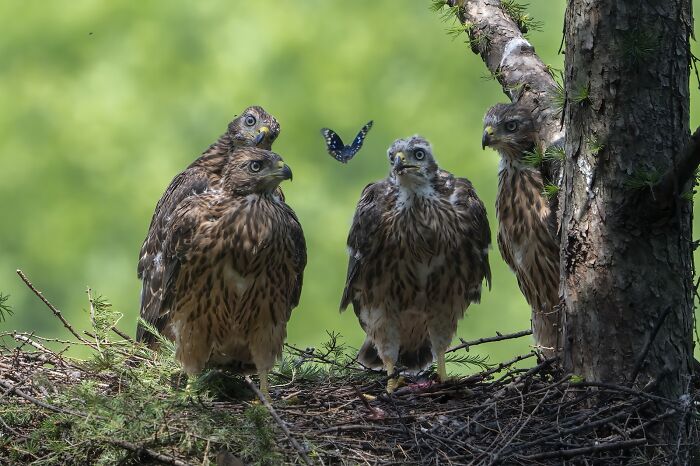
Image source: naturesbestphotomagazine
#23 Highly Honored, Animal Antics: Ring-Tailed Lemurs By Andy Rouse Of Usk, Wales, UK
“While working at a favorite reserve photographing ring-tailed lemurs, I discreetly followed a female as she fed. The youngster on her back was quite mischievous, constantly jumping off and playing. At one point, it grabbed its own tail and started entertaining itself with it.”

Image source: naturesbestphotomagazine
#24 Highly Honored, Wildlife: Brown Lemurs By Donglin Zhou Of Hangzhou, China

Image source: naturesbestphotomagazine
#25 Highly Honored | Animal Antics | Honey Possum On Banksia Plant By Mitchell Roberts Of Toowoomba, Queensland, Australia
“I remember waking up before sunrise to head out in search of a honey possum for the first time. As the sun rose, I walked along a sandy track, carefully observing the banksias. After two hours of searching, with light clouds rolling in, I was about to move on when, out of the corner of my eye, I spotted some movement! From that moment, I spent the entire day with a group of them, learning their behaviors. I even found a female with a young in her pouch moving between the flowers.”

Image source: naturesbestphotomagazine
#26 Highly Honored, Wildlife: Ring-Tailed Lemurs By Bence Máté Of Pusztaszer, Hungary

Image source: naturesbestphotomagazine
#27 Highly Honored, Animal Antics: Gentoo Penguin Diva By Charles Janson Of Huson, Montana, USA
“This penguin was caught in the middle of an intense bout of feather preening, bending its head and flippers into many interesting and contorted positions. I named this shot ‘Penguin Diva,’ as it reminded me of a singer performing her aria.
All penguins spend a large portion of their time on land preening. Although their feathers are short compared to most birds, they provide essential protection from the cold Antarctic waters. Waterproof feathers are just one of several adaptations penguins have to survive the extreme conditions in which they breed and find food.”

Image source: naturesbestphotomagazine
#28 Highly Honored, Wildlife: Giraffes By Amy Gerber Of Cody, Wyoming USA

Image source: naturesbestphotomagazine
#29 Highly Honored, Birds: Squacco Herons By Antonio Aguti Of Monte San Savino, Arezzo, Italy
“In spring, these migratory birds become highly active, both in their search for food and in courtship. Before dawn, from my floating hide, I immersed myself in the lake’s waters to gain the best possible vantage point. As the first rays of sunlight broke over the horizon, these two egrets gifted me this beautiful moment.”
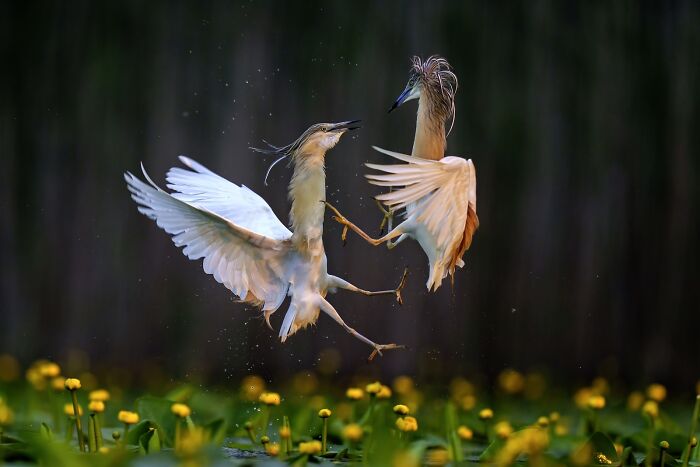
Image source: naturesbestphotomagazine
#30 Highly Honored, Wildlife: Young Gorilla Nap Time By David Swindler Of Kanab, Utah, USA

Image source: naturesbestphotomagazine
#31 Highly Honored, Wildlife: Desert Kit Fox Pup With Feather By Beaumon Day Of Highland, Utah, USA

Image source: naturesbestphotomagazine
#32 Winner, Animal Antics: Mountain Gorillas By David Swindler Of Kanab, Utah, USA
“These two gorillas were comical to watch—the smaller sibling pestered the bigger one until he was finally swatted away. While trekking through the dense vegetation, our group captured many humorous interactions. Tourism in Bwindi’s primeval forest plays a vital role in supporting this critical habitat for gorillas.”

Image source: naturesbestphotomagazine
#33 Highly Honored, Wildlife: Hippopotamus By Samir Kamat Of Atlanta, Georgia, USA

Image source: naturesbestphotomagazine
#34 Highly Honored, Polar Passion: Young Polar Bear And Walrus By Florian Ledoux Of Kvaløya, Norway
“This young female polar bear was absolutely fearless. On that night, like many others, she decided to chase walruses resting on the broken fast ice. For several days, her routine was nearly the same. She would wake up in the late afternoon and slowly move across the solid fast ice, going from seal hole to seal hole. But with little patience for traditional seal hunting, she would soon make her way to the ice’s edge, clearly enjoying herself as she chased the walruses—a mix of play and curiosity. After a while, she would have had enough and head off to the hills and mountains, where she would take down a reindeer, eat, sleep, and repeat.”

Image source: naturesbestphotomagazine
#35 Highly Honored, Ocean Views: Larval Tripod Fish By Steven Kovacs Of Palm Beach, Florida, USA
“A favorite subject to encounter on a blackwater dive is the beautiful larval Tripod fish. Like many other larval fishes, the young of this species have large, rounded fins that they can use to mimic jellyfish, helping them stay camouflaged from predators. Their fins are more spectacular than most other fish, and the wide range of color variations is truly breathtaking. Most of the time, these fins may be tucked to the sides or not symmetrically open, so the key to capturing the true beauty of these fish is to photograph them when their fins are fully extended on both sides.”

Image source: naturesbestphotomagazine
#36 Winner, Conservation Story: The Great Turtle Rescue By Sandesh Kadur Of Bangalore, Karnataka, India
“February 2021 brought an incredible cold weather event, a rare Arctic cold front that froze pipes, destroyed the power grid, and plunged South Padre Island into disaster. But something else happened that brought residents out of their homes—the sight of thousands of cold-stunned, suffering, and freezing green sea turtles along Laguna Madre Bay.
The cold-blooded reptiles were unable to regulate their body temperature and metabolism to stay active. With water temperatures dipping below 50°F, turtles struggled to stay afloat to breathe. Thought to be the largest cold-stunning event of green sea turtles in recorded history, over 5,000 incapacitated turtles started washing up on the beach, found floating on the water, paralyzed by the cold.
Green sea turtles are predominantly herbivorous as they mature, preferring seagrass meadows to any other habitat and usually staying close to the shallows of the bay. As the cold front swept in, the upper waters of the bay froze, killing thousands of turtles and other aquatic life that could not escape to deeper, warmer waters—a colossal loss of marine biodiversity.
It was then that South Padre residents braved the freezing temperatures to start rescuing turtles of every size, from hatchlings to adults. They collected the animals by carload and brought them to rescue and rehabilitation centers on the island. Soon, thousands of motionless turtles were resting on tarps, slowly being warmed and revived.
It is rare to witness a community coming together to protect a wild species, especially while dealing with their own struggles during a severe cold wave that affected their entire town. Power, water, and gas supplies were all impacted, yet they united to rescue over 5,000 green sea turtles and support a four-decade-long conservation program aimed at protecting the species.
Without this incredible effort, the island’s entire turtle population could have been decimated—a massive loss to decades of conservation work. Stories like this deserve to be told to a global audience, perhaps inspiring many to join hands in protecting their local wildlife.”

Image source: naturesbestphotomagazine
#37 Highly Honored, Animal Antics: Bull Moose By Deena R. Sveinsson Of Estes Park, Colorado, USA
“This wildlife photographer clearly understands the importance of camouflage — both for himself and his camera gear — to blend into his surroundings. As he prepares to take his shot, he takes a solid stance and carefully places his eye at the viewfinder, waiting patiently for his subject to come into view.
After an evening snowfall in Grand Teton National Park, Wyoming, USA, photographers woke up to a blanket of snow covering the sage flats. It was a relatively slow morning, watching the many bull moose eat their breakfast of bitter brush. A group of us was photographing a bull moose as he ate his way toward us, moving a few steps every ten minutes before resuming his meal.
At some point, the bland brush bored him, and he decided to go on a walkabout — straight toward all the photographers. We quickly moved away to give him space, but in the rush, a tripod and camera were left behind.
At first, the bull moose ignored the gear, thrashing his antlers on the brush. But curiosity got the better of him, and he approached the camera gear. He began licking it, seemingly enjoying the taste, and even appeared to inspect the camera as if trying to look through the viewfinder. I captured this hilarious moment on camera. After a while, he pushed the tripod and gear into the snow and wandered off. Fortunately, the equipment landed softly in the snow and was unharmed. We couldn’t stop laughing.”

Image source: naturesbestphotomagazine
#38 Highly Honored, Animal Antics: Brotherly Hug By Daniel Valverde Fernández Of Madrid, Spain
“This image was captured in the middle of the Malaysian jungle in the state of Sabah, located in northern Borneo.
Sabah is the only place on Earth where proboscis monkeys are found in the wild. This photo shows two monkeys embracing after a minor argument. It captures how this species can display such human-like behaviors and expressions, including a reconciliation hug and a surprising look of tranquility and joy. This moment is a striking reminder of how humans can learn from animals and why it is crucial to protect them and prevent their extinction.”
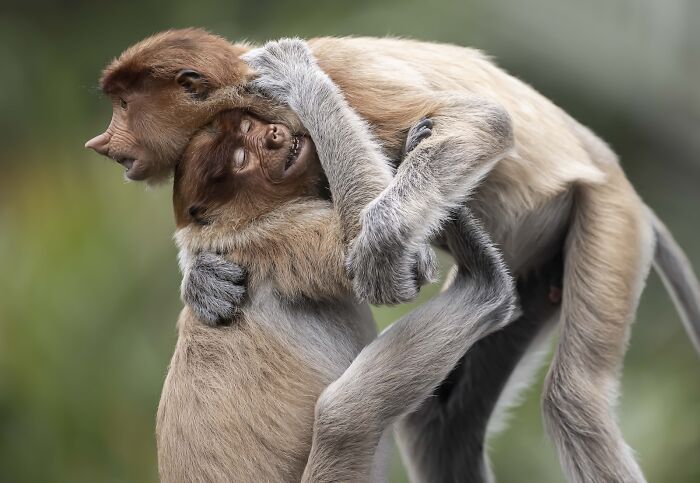
Image source: naturesbestphotomagazine
#39 Highly Honored, Youth: Saltwater Crocodile And Wallace’s Flying Frog By Genia Ikhfa Anindita, At Age 13, Of Haruai, Tabalong, Indonesia
“My dad and I came across a rare moment in the Borneo jungle. A frog and a hatchling crocodile happened to be near each other among the wet bushes and a small stream. As I approached to photograph them, the frog suddenly jumped onto the top of the hatchling’s mouth. Startled by the sudden movement, the little crocodile closed its eyes, as if in disbelief at the audacity of its tiny guest. It was a brief moment, but full of drama and humor—a meeting between two swamp creatures that neither expected.”

Image source: naturesbestphotomagazine
#40 Highly Honored, Wildlife: African Elephant Clan By Kathy Karn Of Campbellville, Ontario, Canada

Image source: naturesbestphotomagazine
#41 Highly Honored, Outdoor Adventure: Spy Hopping Humpback Whale By Torie Hilley Of Ventura, California, USA
“It was slow going at first for whale photography in Monterey Bay. But toward the end of our session, we were joined by two “friendly” humpbacks. They casually swam around us and the neighboring boat, occasionally sticking their flukes out nearby. At one point, one of the whales lifted its head to check out the neighboring boat. It amazes me how these gentle giants sometimes choose to hang out with us in boats.”
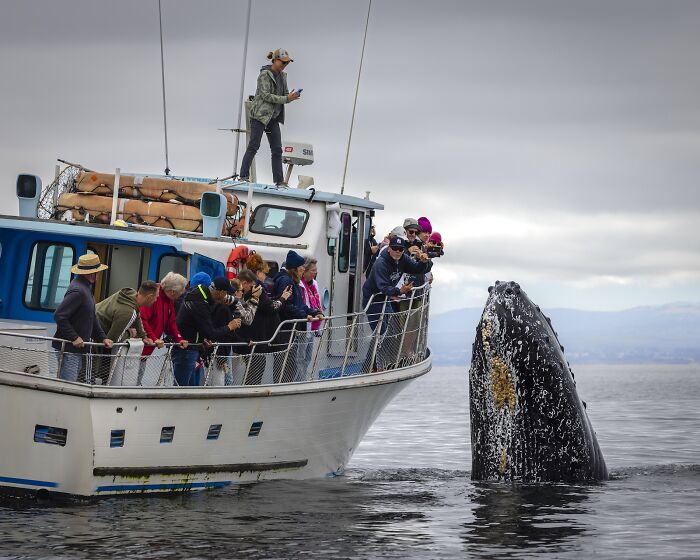
Image source: naturesbestphotomagazine
#42 Highly Honored, Conservation Single Image: Coral Nursery, Hawksbill Sea Turtle, Iucn Status: Critically Endangered By Dr. Tom Shlesinger Of Eilat, Israel
“In this image, a hawksbill turtle investigates a coral nursery known as ‘the igloo.’ This dome-shaped artificial reef, created over two decades ago, stands as a testament to the delicate balance between human intervention and wildlife preservation. Shortly after coral transplantation onto the igloo, a natural proliferation occurred, attracting a myriad of fish species and other marine life to thrive around this unique structure. While the image shows a turtle in its natural environment, the coral nursery subtly reflects the interplay between conservation efforts and the innate freedom of marine life.”

Image source: naturesbestphotomagazine
#43 Highly Honored, Art In Nature: Backlit Owlfly By Thibault Andrieux Of Mougins, Alpes-Maritimes, France
“This was one of my first encounters with the common owlfly (the French common name for this species). This individual is much more colorful than the sulfurous owlfly I’m more used to seeing, so I wanted to create an image that would highlight the vibrant wings and their delicate veins. Luckily, it was ideally perched, allowing me to do just that. To capture this image, I placed a flash behind the ascalaphe to create backlighting and carefully adjusted the flash power and shooting settings to completely darken the vegetation in the background.”

Image source: naturesbestphotomagazine
#44 Winner, Art In Nature: Lake Clark National Park & Preserve By Henry H. Holdsworth Of Jackson, Wyoming, USA
“Each summer, I run a grizzly bear workshop in Lake Clark National Park, Alaska. I love returning each year to check on my favorite bears, see which ones have new cubs, and share these experiences with my friends and clients. Over the past 10 years, I have consistently sought new angles and perspectives to showcase the bears and their habitat in unique ways.
As a biologist, I’m always on the lookout for interesting natural phenomena, and I enjoy adding to my collection of animal tracks. Since this area of Lake Clark lies in a tidal zone, most tracks are washed away each day with the changing tides. I keep a sharp eye out for a good set of tracks in the mud. On this day, while photographing a bear, I came across tracks where many bears had passed through in different directions. I positioned the camera as high as possible to capture the crisscrossing tracks across the cracked mud. I particularly loved how the oozing mud and the lighting made the tracks appear raised in places, giving them a slightly three-dimensional effect. It remains my favorite shot of tracks to date.”

Image source: naturesbestphotomagazine
#45 Highly Honored, Polar Passion: Harp Seal By Roberta Olenick Of Vancouver, Bc, Canada
“Whiskers thickly coated in ice, a female harp seal emerges from a breathing hole in the sea ice, just one among the thousands of mothers here to nurse their whitecoat pups in the Gulf of St. Lawrence.
Harp seals need vast, stable expanses of thick pack ice to successfully raise their young. The year I was there, the ice was so solid and extensive that it took me two tries to reach the main breeding colony. My first attempt was on a multi-day voyage aboard a steel-hulled vessel repurposed from seal hunting to eco-tourism. We never managed to break through the ice to the primary nursery, but fortunately, we discovered a smaller, accessible group that offered wonderful opportunities for photographing the seals. To experience the grand extent of the main colony, I had to try again, this time by helicopter.
“The ice that year may have impeded boat travel, but it was just great for the seals themselves. Sadly, such favorable ice conditions are becoming increasingly rare. With climate change, the North Atlantic pack ice is declining and becoming more unpredictable. In low-ice years, far too many seal pups drown or get crushed in broken ice, with pup mortality sometimes exceeding 90% in the Gulf of St. Lawrence.”

Image source: naturesbestphotomagazine
#46 Highly Honored, Birds: Prairie Chicken Jump-Off By Peter Hudson Of Port Matilda, Pennsylvania, USA
“A ‘jump-off’ between two Greater Prairie Chickens illustrates their remarkable aerial combat, where one bird launches into the air attempting to strike its opponent, triggering a reciprocal jump attack by its adversary — so they are often in the air at the same time.
I have a lifelong passion for grouse species, and I enjoy nothing more than sitting in a small hide on a remote hillside, watching and photographing these fascinating birds. Most grouse species exhibit lekking behavior, where males compete in communal arenas to attract the attention of females.
Early biologists interpreted this as simple male-to-male competition, much like a medieval tournament where the winner claims the female as a prize. However, it is now becoming apparent that it is not the male winning the female, but rather the female selecting the male, that drives these displays. Females evaluate males using a range of behavioral and physical traits.
Interestingly, males consistently engage with the same territorial neighbor, forming predictable rival pairs that surprisingly tolerate each other well when females are absent. Different species use similar calls and behavioral displays, but these vary with body size — so these smaller grouse jump much higher.
This complex social dynamic is utterly fascinating.”

Image source: naturesbestphotomagazine
#47 Winner, Wildlife: Male Jaguars By Hira Punjabi Of Thane, India
“This image of two jaguars in a single frame was one of the most challenging I’ve ever captured. I spent six full days boating through the Pantanal on safari, tracking these males. After several failed hunting attempts, they finally paused to rest—giving me a rare opportunity to compose them together in one shot.”

Image source: naturesbestphotomagazine
#48 Highly Honored, Wildlife: Red Squirrel By Simon Roberts Of Chapel Stile, Cumbria, UK

Image source: naturesbestphotomagazine
#49 Highly Honored, Ocean Views: Green Turtle By] Henley Spiers, Devon, England, UK

Image source: naturesbestphotomagazine
#50 Highly Honored, Birds: Drongos In Flames By Baiju Patil Of Aurangabad, India
“Just before the onset of winter, sugarcane fields are harvested, leaving dry leaves scattered across the land. Beneath these fallen leaves, countless insects thrive, hidden away for weeks. When farmers finally set fire to the leftover stubble to clear the fields, the intense heat forces the insects out in a desperate bid to escape.
From a distance, drongos spot the thick plumes of smoke curling into the sky. Instinctively, they gather near the burning fields, knowing a feast awaits. The moment the insects burst into the open, the drongos launch into action — diving, twisting, and darting with breathtaking speed to snatch their prey from midair.
Unlike most birds that shy away from fire, drongos embrace the chaos. They plunge straight into the dense smoke and swirling embers, maneuvering with astonishing precision through the shimmering heat. Often hunting in small groups, they display remarkable coordination, weaving in and out of the fiery haze with effortless grace.
Their sleek, glossy black feathers gleam against the orange glow of the flames, creating a striking contrast that turns this hunt into a visual spectacle. This image freezes one such moment in time — a drongo suspended in mid-flight, wings outstretched, eyes locked on its prey. It stands as a vivid testament to nature’s resilience, adaptability, and the bold survival tactics of one of the most fearless birds in the wild.”

Image source: naturesbestphotomagazine
 Follow Us
Follow Us





